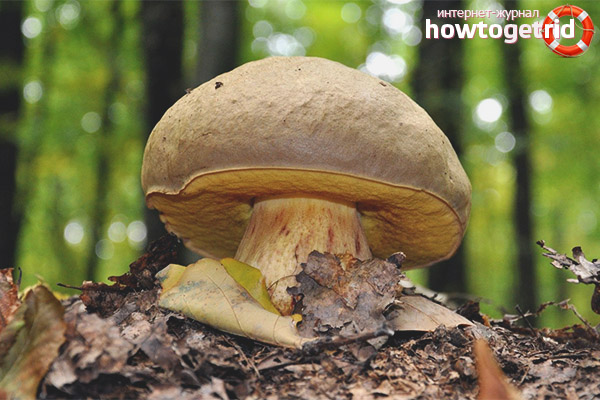The content of the article
He received this name from the people. The most common scientific name is Boletus impolitus. In some literature it is also found under the names: half-white sick, boletus yellow, as it represents the family of boletus, the genus of boletus. Semi-white mushroom is considered one of the most delicious mushrooms that live in our forests. To date, it is quite rare and will soon be listed in the Red Book as an endangered species.
Description
Semi-white mushroom or yellow boletus is an edible, tubular representative of the mushroom family. Mostly lives in mixed or deciduous forests of our homeland. Very fond of calcareous soil. Convenient for collecting time is from July to September, most often such a mushroom can be found under the oak.
- The size of his hat is initially 5-6 cm, and in an adult mushroom it can reach 20-22 cm. Such sizes for mushrooms are considered a record. Initially, it is strongly convex in the young fungus, and then during growth it becomes pillow-shaped, flattened and torn. The skin is dull, does not separate from the pulp. Color characteristics in nature are found in different shades - from tan to olive and gray-brown. The lower tubular layer is golden.
- The foot is thickened to 7 cm, reaches a height of 10-12 cm. Rough to the touch, closer to the root, coarse-fibrous. Inside is a straw-lemon color, on top of a burgundy.
- The pulp is powerful, thick. In general, the color is golden wheat, in some places near the legs the color is rich lemon. The smell of such a mushroom is vaguely reminiscent of the smell of gouache paints or, as many say, it has a carbolic smell.
- Part of the fruiting body of the fungus is porous-tubular with a density of one to three cm. The pores are small and slightly rounded. The color in young mushrooms is greenish, in older representatives yellow. When cut or damaged, the color does not change.
- The pores are flat, even brown.
Habitat and time of collection
Semi-white mushroom is a very thermophilic mushroom family. Therefore, it mainly lives in the southern and central part of the Russian Federation, it can also be found in some parts of the Carpathian mountains. You need to look for yellow boletus in mixed forests, often found in coniferous forests. Especially likes moist calcareous soil. In favorable weather, fruit from the beginning of summer to late autumn. Despite the fact that recently it is extremely rare, in a favorable year with suitable conditions, you can harvest a very large crop.
Taste characteristics and benefits
Yellow boletus - an edible mushroom, allowed for consumption. Itself is very tasty, has a high rating among mushroom pickers. The specific smell disappears during cooking.
Semi-white mushroom is suitable for different types of cooking. Most often it is dried, pickled, boiled and fried. Mycologists claim that the variety of this fungus is very useful for the human body. When eaten, a person receives a large amount of vitamin B, as well as:
- Helps to improve the functioning of the nervous system.
- Positive effect on the hair and skin.
- It normalizes the endocrine system.
- Helps improve hemoglobin levels in the body.
- Strengthens bone tissue.
- Improves the immune system.
Due to the fact that the fungus is rich in ascorbic acid, it is recommended to use it for acute respiratory infections. In the case of constant eating, the chance of getting a cold, flu is significantly reduced.
It is especially important to remember that even when frozen, the mushroom retains all the beneficial elements. This is a big plus when preparing the hostess for the winter.
Contraindications
This mushroom is prohibited:
- Children under 10 years of age (the digestive system is not fully formed).
- People suffering from diabetes mellitus (disaccharide is present in the fungus).
- People suffering from kidney diseases (the mushroom may contain a large amount of nitrates).
The semi-white mushroom does not have any substances that could harm a person. But it is important to remember that the mushroom absorbs all the substances from the soil, so you should not collect it near roads, factories, highways and other ecologically polluted areas of our nature.
Similar species
- Boletus edulis is the common name for cep.
- Boletus appendiculatus - girlish fight.
- Boletus radicans, syn, Boletus albidus is a highly deep-rooted poisonous mushroom (the color of the hat for such a mushroom is gray, the legs and pores of the lemon turn blue when pressed, which differs from the Semi-white mushroom).
In connection with the disappearance of this species, scientists urge to treat it with care and understanding. So that our descendants could also enjoy the yellow boletus.
Video: semi-white mushroom (Boletus impolitus)











Submit